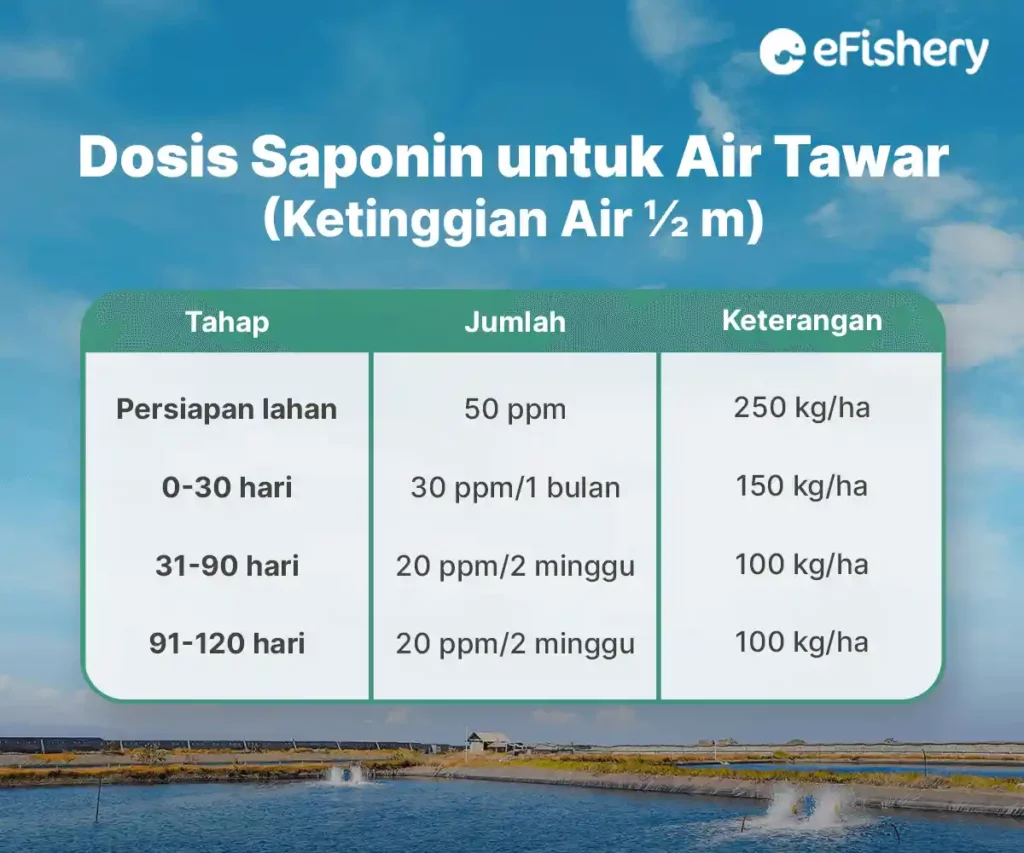Artikel Ini Telah Direview Oleh:

Nabilla Anggi
Magister Budidaya Perairan
"Do saponins kill shrimp?" is one of the questions that are often asked by farmers, especially novice farmers. This is because farmers are often worried that the use of saponins will have a negative impact on shrimp.
The function of saponins is to kill pests such as antimicrobials, snapper, seli fish, kuro fish, and various other types of carnivorous fish. If left unchecked, pond aquatic pests will have a negative impact on the survival of shrimp. To avoid these adverse effects, farmers often use saponins in their ponds.
Saponins are indeed one of the best weapons against predatory pests in pond waters. However, saponins have toxic side effects for pond aquatic biota. Check out the explanation here!
Explanation of Saponins
Saponins are secondary metabolites in plants that are used as organic pesticides. Saponins are commonly used in shrimp ponds because they are toxic to cold-blooded animals. Saponins are in the form of coarse brown flour and are derived from the seeds of the tea plant Camellia oleifera. Saponins have several functions for shrimp pond waters, such as:
- Control pests (competitors or predators)
- Stimulate the change of shrimp skin / molting
- It is antifungal or antifungal
- Antibacterial
Do Saponins Kill Shrimp?
Control and eradication of predators in shrimp farming in ponds can be carried out using saponins with lethal doses for pond predators. Giving saponins also has a function to stimulate the process of changing the skin or molting in shrimp.
Although saponins are toxic and produce strong reactions, they are only toxic to cold-blooded animals and will not affect cultured shrimp. As a result, the use of saponins will not kill the shrimp being cultivated.
Safe Dosage for Using Saponins
In traditional pools, you can use the following doses:


The saponin dosage commonly used in ponds is 15-25 mg/L. The higher the salinity, the lower the dose used.
Here's how to use saponins for shrimp ponds:
- Soak the seeds of the tea plant Camellia oleifera for 24 hours in a container so that the saponins dissolve in water.
- After soaking overnight, pour the marinade into the pond evenly. The dregs of the tea plant seeds can also be sprinkled into the pond, because the dregs that fall to the bottom of the pond will become organic fertilizer.
- Flatten the application of saponins using a pond wheel.
Consult the Proper Use of Saponins Through the Cultivation Consultation Feature on eFarm!
Need Help Regarding Shrimp Cultivation Business?
Fill in your personal data in the following form. Our team will immediately contact you via the number cellphone attached. Make sure the data entered is correct.
Using the right saponins can protect your pond from predators. However, in order to use it effectively, you should consult the dosage with a shrimp cultivation or aquaculture expert. Therefore, You can take advantage of the features Cultivation Consultation in app eFarm!
eFarm is an application that provides various solutions for shrimp farmers in managing their ponds. Application eFarm provides complete features in supporting shrimp farming, one of which is Cultivation Consultation which connects you with Aquaculture experts for consultation.
Come consult an Aquaculture expert at eFarm Now!

Nabilla Anggi - Magister Budidaya Perairan
Nabilla merupakan lulusan sarjana dan magister budidaya perairan serta memiliki pengalaman di dunia perikanan baik hatchery maupun pembesaran
Questions About Do Saponins Kill Shrimp
Although saponins are toxic and produce strong reactions, they are only toxic to cold-blooded animals and will not affect cultured shrimp. As a result, the use of saponins will not kill the shrimp being cultivated.
Safe doses for using saponins depend on the type of pond water, water level, and the stage of shrimp cultivation. You should consult the dosage with a cultivator or aquaculture expert, as in the Cultivation Consultation feature in the eFarm application which can be accessed free of charge
- DKPP. Food Security and Fisheries Office of the Buleleng Regency Government. 2021. Prevent Pests in Shrimp and Milkfish Ponds with Saponins.
- DKPP. Gunungkidul Regency Government Food Security and Fisheries Service. 2020. Saponins in Tea can Kill Fish Predators or Competitors in Fish Farming Ponds.
- Hidayat, SS 2018. Cultivating vannamei litopenaeus vannamei shrimp with extensive plus technology. Research Center for Brackish Water Aquaculture and Fisheries Counseling. 67 p.
- Iqbal. 2021. Saponins, Prevent Shrimp and Milkfish Predators in Ponds. Tabloidsinartani.com.
- Lilis and Adawiyah R. 2021. The Effect of Using Saponins with Different Doses on Pest Control in Vannamei Shrimp Ponds in Term District. Arowana Scientific Journal of Aquatic Studies Program. Vol.3(1):24-27.
- Lilis and Rabiatul. 2021. The effect of using different doses of saponins on pest control in vannamei shrimp (Litopenaeus vannamei) ponds in the District of Jangka. Scientific Journal of Aquatic Studies Program, 3(1), 24-27.
- Ngginak, J., MT Apu and R. Sampe. 2021. Analysis of saponin content in ripe palm fruit fiber extract (Borassus flabellifer Linn). Bioeducation. 12(2):221-228.
